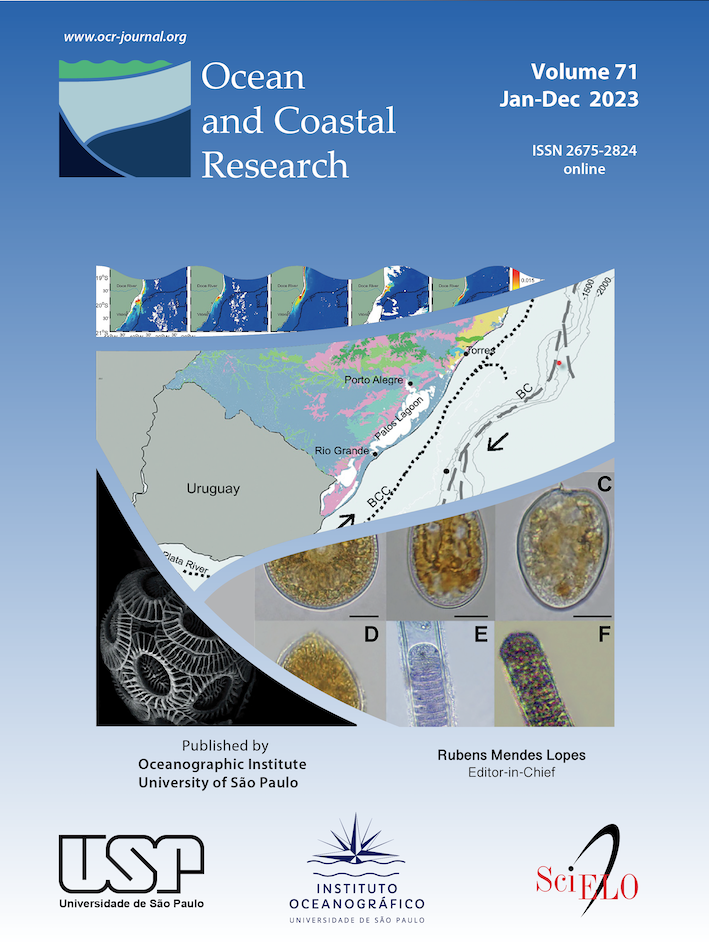Obtaining surface current field from drone imaging
DOI:
https://doi.org/10.1590/Keywords:
Coastal hydrodynamicAbstract
Knowledge of coastal hydrodynamics is essential for understanding the processes of transport of dissolved or particulate material since in these areas there are large ports and the vessel traffic with a greater possibility of accidents. Studies related to currents are of fundamental importance to support decision-making to mitigate environmental impacts. The present work aims to test the technique of measuring currents through drones, as it has the advantage of a quick response in obtaining and analyzing data. For this study, a field survey was carried out in the region of the mouth of Lagoa dos Patos, RS, Brazil. The method's validation was done through the use of a colored tracer in which it was used to measure the surface current velocities simultaneously with the vectors generated by the drone. The results obtained a percentage difference between the methods of 10%, both for speed and for current direction, showing to be very promising for the use of drones to obtain surface current fields. In this way, it opens a new perspective in carrying out field experiments, so new experiments will be carried out to verify the feasibility of using this technique in different conditions, such as in the surf zone and areas with the presence of density fronts.
References
ELTNER, A., SARDEMANN, H. & GRUNDMAN, J. 2020. Flow velocity and discharge measurement in rivers using terrestrial and unmannedaerial-vehicle imagery. Hydrology and Earth System Sciences, 24(3), 1429-1445.
FONG, D. A. & MONISMITH, S. G. 2004. Evaluation of the Accuracy of a ShipMounted, Bottom-Tracking ADCP in a Near-Shore Coastal Flow. Journal of Atmospheric and Oceanic Technology, 21(7), 1121-1128.
HALPERN, B. S., WALBRIDGE, S., SELKOE, K. A., KAPPEL, C. V., MICHELI, F., CASEY, K. S., FOZ, H. E. & HEINEMANN, D. 2008. A global map of human impact on marine ecosystems. Science, 319(5865), 948-952.
LUMPKIN, R. & PAZOS, M. 2007. Measuring surface currents with Surface Velocity Program drifters: the instrument, its data, and some recent results. Lagrangian Analysis and Prediction of Coastal and Ocean Dynamics, 39, 67.
MARONE, E., SCHETTINI, C. A. F., SIEGLE, E., NIENCHESKI, L. F., MADUREIRA, L. A. S. P, WEIGERT, S., PINHO, M. P. & COLETTO, J. L. 2020. Oceanografia operacional. In: LANA, P. C. & CASTELLO, J. (orgs.). Fronteiras do conhecimento em ciências do mar. Rio Grande: FURG, pp. 54-92.
MOOERS, C. N. K., STANLEY, D. J. & SWIFT, D. J. P. 1976. Marine sediment transport and environmental management. In: STEWART, R. H. (ed.). Introduction to the physical oceanography and fluid dynamics of continental margins. New York: Wiley, pp. 7-21.
NOVI, L., RAFFA, F. & SERAFINO, F. 2020. Comparison of measured surface currents from high frequency (HF) and X-band radar in a marine protected coastal area of the Ligurian sea: toward an integrated monitoring system. Remote Sensing, 12(18), 3074.
PERKOVIC, D., LIPPMAN, C. & FRASIER, J. 2009. Longshore surface currents measured by doppler radar and video PIV techniques. IEEE Transactions on Geoscience and Remote Sensing, 47(8), 2787-2800.
POULAIN, P. M., WARN-VARNAS, A. & NIILER, P. P. 1996. Near-surface circulation of the Nordic seas as measured by Lagrangian drifters. Journal of Geophysical Research: Oceans, 101, 18237-18258.
STRELNIKOVA, D., PAULUS, G., KÄFER, S., ANDERS, K., MAYR, P., MADER, H. & SCHNEEBERGER, R. 2020. Drone-based optical measurements of heterogeneous surface velocity fields around fish passages at hydropower dams. Remote Sensing, 12(3), 384.
STRESSER, M., CARRASCO, R. & HORSTMANN, J. 2017. Video-based estimation of surface currents using a low-cost quadcopter. IEEE Geoscience and Remote Sensing Letters, 14(11), 2027-2031.
YUROVSKY, Y., KUBRVAKOV, A., PLOTNIKOV, V. & LISHAEV, N. 2022. Submesoscale currents from UAV: an experiment over small-scale eddies in the coastal black sea. Remote Sensing, 14(14), 3364.
Downloads
Published
Issue
Section
License
Ocean and Coastal Research is an open-access journal available through SciELO (Scientific Electronic Library Online).
Ocean and Coastal Research journal title abbreviation is Ocean Coast. Res. and should be used in footnotes, references, and bibliographic entries.
All Ocean and Coastal Research scientific articles are freely available without charge to the user or institution. In accordance with the BOAI definition of open access, all contents are available to readers free of charge. Users may read, download, copy, and link to the full texts of the articles. They may be used for any lawful purpose without prior authorization from the publisher or the author, as long as proper credit is given to the original publication.
All Ocean and Coastal Research published scientific articles receive an individual Digital Object Identifier (DOI) persistent digital document identification.
All the content of the journal, except where otherwise noted, is licensed under a Creative Commons License type BY. Authors retain the copyright and full publishing rights without restrictions.
More information on intellectual property can be found here and on Scielo's Open Acess Statement.
Ocean and Coastal Research is listed in Publons and reviewers and editors can add their verified peer review and editing history to their Publons profile.
Ocean and Coastal Research is indexed in the Directory of Open Access Journals (DOAJ) and complies with principles of transparency and best practice for scholarly publications.
Ocean and Coastal Research is committed to the best standards in open-access publishing by adopting ethical and quality standards throughout the publishing process - from initial manuscript submission to the final article publication. This ensures authors that their work will have visibility, accessibility, reputation, usage, and impact in a sustainable model of scholarly publishing.




